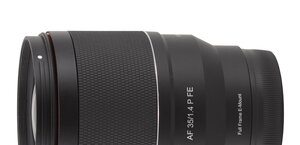Nikon Nikkor Z MC 50 mm f/2.8
4. Image resolution
Let's check how the Nikkor Z MC 50 mm f/2.8 compares- its results in the frame centre, on the edge of the APS-C/DX sensor and on the edge of full frame presents a graph below.

Please Support UsIf you enjoy our reviews and articles, and you want us to continue our work please, support our website by donating through PayPal. The funds are going to be used for paying our editorial team, renting servers, and equipping our testing studio; only that way we will be able to continue providing you interesting content for free. |
- - - - - - - - - - - - - - - - - - - - - - - - - - - - - - - - - - - - - - - - - - - - - - - -
The performance in the frame centre is undoubtedly bvery good. Already at the maximum relative aperture you deal with MTF values exceeding a very high level of 60 lpmm, and on stopping down the aperture the resolution is able to get to 75-77 lpmm. It seems Nikon optics specialists did a really good job because the maximum result of the Nikkor Z MC 2.8/50 is a tad higher than the resolution of the much faster Nikkor Z 1.2/50. Of course you should mention the fact that the tested lens didn't manage to break the level set by the Nikkor Z 1.8/50. Still, in general f/2.8 lenses find it hard to compete with much faster models with the maximum relative aperture of f/1.2-1.8.
The results on the edge of the smaller APS-C/DX sensor are good as well. By f/2.8 the lens lands firmly above the decency level and stopping down of the aperture improves the whole performance even further – as a result, near f/5.6 the lens gets to almost 65 lpmm.
The weakest performance you observe on the edge of full frame and for obvious reasons; still even there you shouldn't be overly worried. At the maximum relative aperture images are decent and their quality improves quite quickly on stopping down. As a result for a wide range of apertures, from f/4.0 to f/11, the lens is able to produce sharp images across the frame – exactly a feature you would like to observe in this type of instrument.
To sum up, even though the Nikkor Z MC 50 mm f/2.8 didn't approach any record-breaking values in this category we still think it fared exceedingly well in the frame centre and didn't have any slip-ups on the edges. It is a performance you would expect from this type of equipment.
At the end of this chapter, traditionally, we presents crops taken from photos of our resolution testing chart; they were saved as JPEG files along with RAW files we used for the analysis above.
| Nikon Z7, JPEG, f/2.8 |
 |
| Nikon Z7, JPEG, f/4.0 |
 |






